If someone always speaks at the same volume, we quickly get bored. If someone sings like that, we get annoyed after a short time. With moderate singers with a sonorous voice, we sometimes feel the same way and switch off.
We need loud and quiet, and everything in between. In a word: "dynamics". We want to hear it in music and song because it reflects the dynamics of life itself. In the loud-quiet changes, we hear the great ups and downs of moving moments, feelings and passions. Just like here in the song "Skinny Love" by singer-songwriter Birdy:
With passionate outbursts of emotion such as joy or anger, singing is like real life: We get loud. Or, with other feelings or moods, quietly to the point of whispering. Unlike in real life, we first have to learn how to do this when singing - at least if we don't want to ruin our voice.
Loud: chest voice and belts
It is a basic skill for singers to switch between loud and soft, depending on what they want to express in a song. They can control how loud or soft they sing in various ways: via the air pressure from below, the choice of vocal register (full, medium or head voice), the oral cavity with the soft palate and the lips (wide or oval).
Your singing becomes loud through:
- a higher air pressure that causes your vocal chords to vibrate from below - just as your lips become louder when you blow more air through them
- Singing with a full voice, with your vocal cords vibrating at full width - called "chest voice", "belting" in the high register
- the "twang" sound, which amplifies the overtones of the vocals - making your voice more sustainable
- a wide-open resonance chamber - from the larynx to the raised soft palate (uvula)
- Open your lips into a wide smile - this will make your tone brighter and more radiant
Just not all at once, please. Singing with a high energy level does not mean singing all the way up. Realise that rock or pop singers don't have to sing that loud, measured in decibels. They use microphones and amplifiers for their vocals, as well as many effects that make their voice acoustically loud. A rule of thumb is: as loud as when speaking with a raised voice is loud enough in rock and pop singing.
To get loud in a rock song, it's not about measurable volume, maximum pressure and so on. For powerful notes in a high register, you don't need too much air pressure, but rather the right activation of your vocal muscle to produce the right sound. Belting. Your vocal muscle is the muscle belly that contracts your vocal cords and allows them to vibrate powerfully across their full width (see picture below). This gives your singing full sonority and power.
Let's stay with what's special about belting for a moment, because you absolutely need belting to power up in the high register: your vocal muscle is tensed just enough to allow your vocal cords to vibrate at full width - no more than necessary so that your vocal cords can still stretch to reach the high notes. This will "breast-voiced mix" in contrast to the mere "Breast voice" with maximally thickened, short vocal cords as when speaking very loudly.
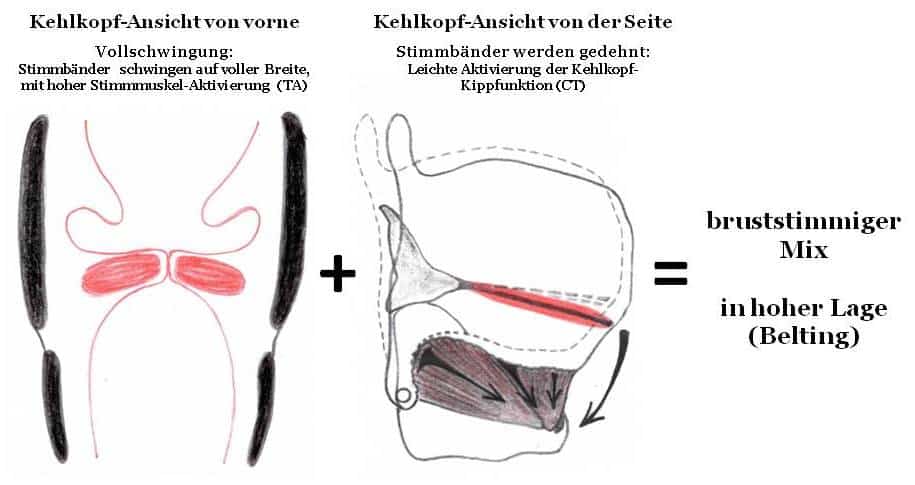
Calling with an open vowel serves as a model for practising the belt: for example, a long drawn-out "Hey" or "Taxi" (English, with "ä") when calling across the street, or a cheerful "Yeah" or "Oy". You can find practice instructions for this in our article on Belting
Quiet: Head voice and twang
The key to the gradation of loud and soft is the right balance between chest and head voice. When you become quieter, you do the opposite of singing loudly (the following does not happen consciously, but rather automatically by becoming quieter): You need less air pressure, and you take tension out of your vocal muscle until your vocal cords only vibrate at the inner edge. This is your "Head voice". With the edge vibration you can sing much higher notes - because you can stretch your vocal cords much further (bottom of picture).
A pure head voice sounds quiet and very thin, with little resonance. Even when singing quietly, however, there is a mix that gives your singing the sound you need. You sing with marginal resonance, but with a little muscle tension from the vocal muscle. Just enough to give your head voice more fullness of sound, a little "core". This is your "head-voiced mix".
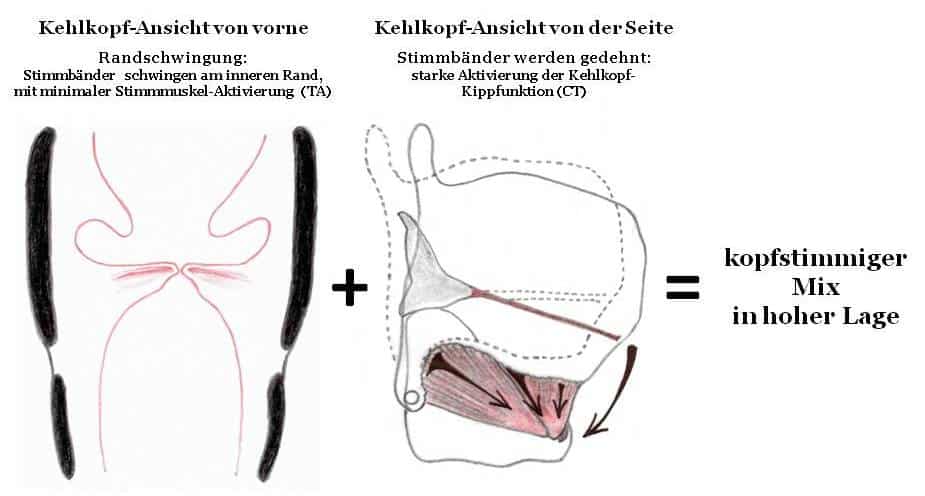
Good singers can give their voice an intense, expressive sound even when singing softly. For example, they retain their Twang sound and also the width of your mouth opening. Both will help you to avoid a drop in tone when singing in top voice. This way you will be quiet, but your top-voiced notes will retain their brilliance. This means that even your quiet singing will come through and get "under the skin" of the audience.
The royal exercise: crescendo and decrescendo
We want to be able to sing loudly, and quietly and intimately. But also everything in between. It is the many nuances in between that we often admire in great stars. The rise and fall of tones with which they so skilfully express sudden flares of passion or surges of emotion.
John Legend does this masterfully here live with the track "All Of Me". Listen to how he lets his vocals rise and fall. And "pulls out all the stops", from chest to head voice:
Letting sounds rise and fall is the main exercise for vocal dynamics. First take a vowel in a comfortable, medium vocal range and let it swell from very soft to very loud. Do it like this:
- Go into a gentle smile, breathe in (only as much as before a surprised exclamation of "Oh!") and sing a long tone: start as quietly as you can with the vowel A (or another open vowel). Then gradually increase the volume until your tone becomes very loud. In music terminology, this is called a "crescendo".
- Make sure you set your tone right from the start. support - Even if your tone is very soft at the beginning and you only need minimal air pressure to sing, keep your chest expanded (flank support) until the end of your tone.
- And add some twang to your tone as early as possible for tonal brilliance.
- If you find it difficult to hold a straight tone, you can add a little Vibrato stabilise.
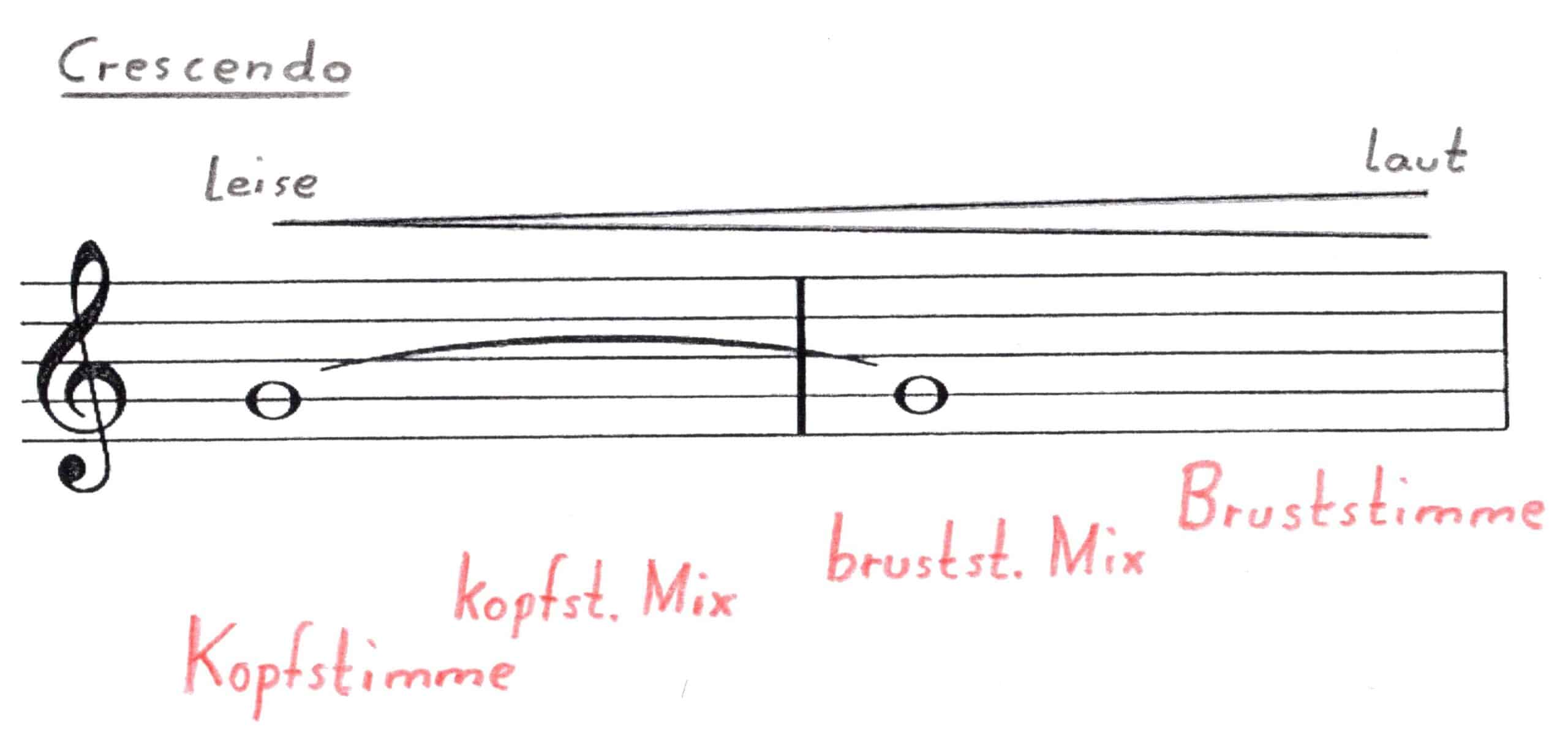
The great thing is: in the course of your crescendo, you went through all the above-mentioned voice registers on just one note. You started with a pure head voice tone and moved on to your middle voice via a head voice mix. From there, roughly in the middle of your crescendo, you moved into a chest voice mix until you reached a full chest voice at the very end.
Now sing the same long tone with a decrescendo. Start loudly, with support and twang, and gradually become softer: from a chest-voiced tone via the two mix levels to the head-voiced end.
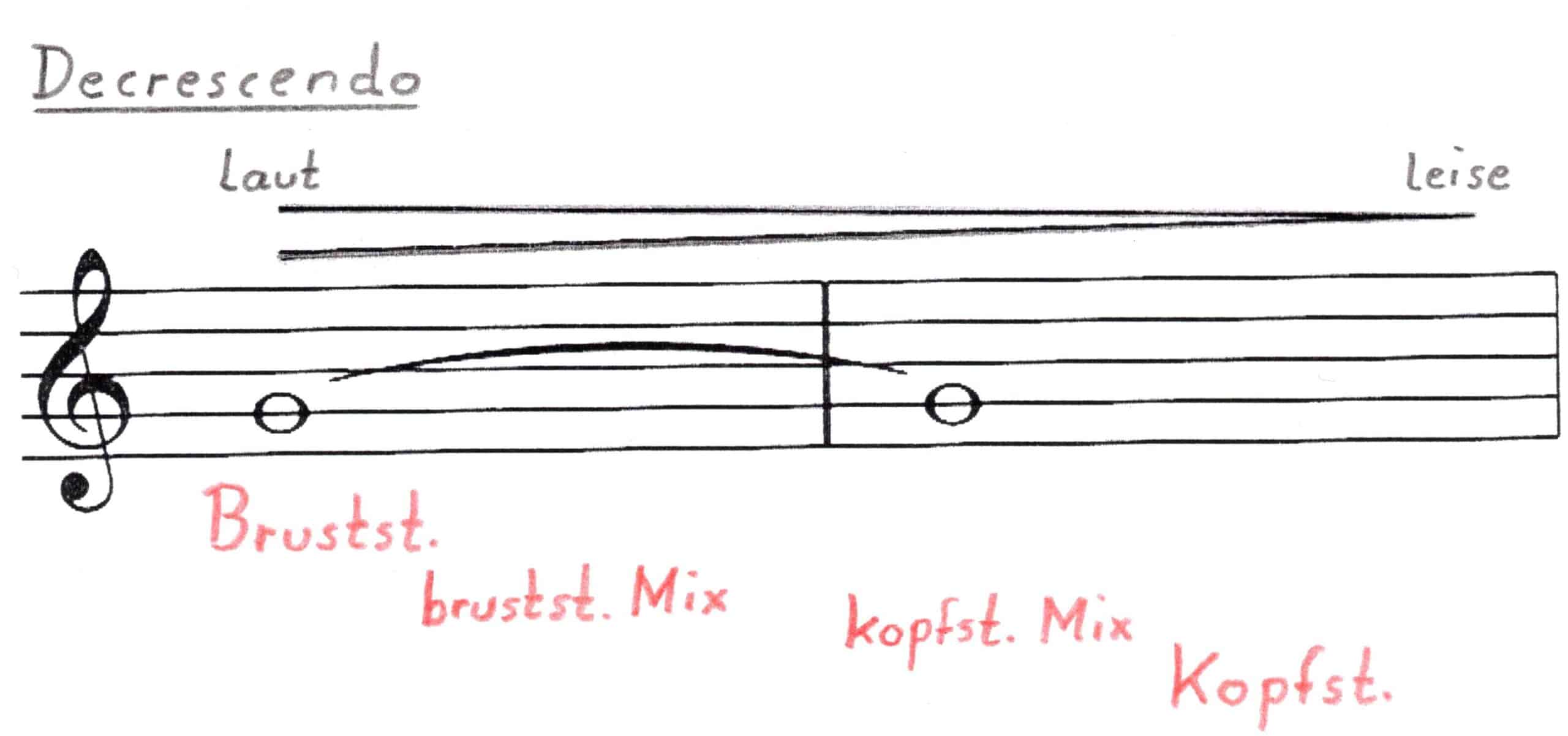
And now both in one breath: sing the long note with crescendo and decrescendo.
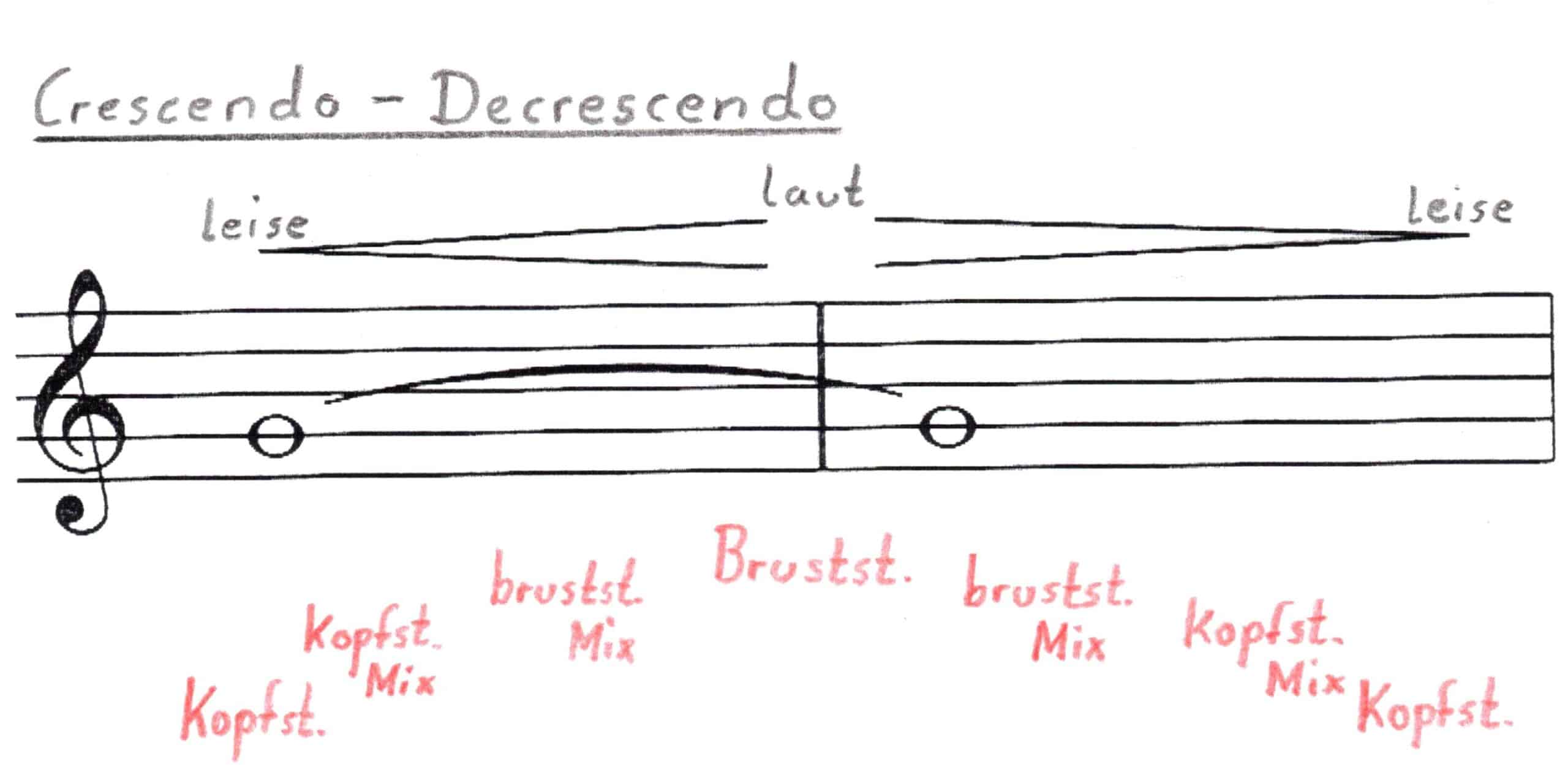
Repeat the exercises by gradually allowing lower and higher notes to rise and fall. Only go as high as you can still sing a crescendo with a secure voice - initially only as high as you can belt. Remember: you can no longer go into the full chest voice in higher registers, but you can go into a powerful chest-voiced mix.
If you go even higher, into high head voice registers, you will only reach a head voice mix with your crescendo. Don't try to force anything in the high register, but utilise the twang and the wide tension of your lips. This will give your head voice tone more core and carrying power without using more force.
What you will learn
The crescendo-decrescendo exercises are a real classic for practising a wide range of volume gradations when singing (in the classical singing tradition they are known as "messa di voce"). But not only that, they also help you practise the basic skills you need to sing:
- Firstly, the Coordination of your voting registersyour chest and head voice, with seamless transitions as described above - this way you learn to use the full range of your voice with a good sonority.
- Secondly, you practise the Support for your notes: Many beginners tend to loosen their breath control and flank support when playing soft notes. This makes the notes breathy or shaky or even chokes them off in high registers. With the crescendos, you learn to keep your flanks wide even when playing soft notes with a minimal air column from below. Not only when your tone is loud, but also when it is soft, you need a lot of support to stabilise it.
- Thirdly, you practise a good Sound attachment one: If you allow your tone to swell gently during the crescendo, this helps you to get away from a hard, "glottal" tone attack, or also from a breathy tone attack with too much air. The gentle swelling of the tone, the so-called "Balanced" sound approachis the most common in rock and pop singing and is easy on the voice.
Application: Adding dynamics to a song line
To finish off this series of exercises, why don't you apply the whole thing to a line of a song? Take a small melody with lyrics and sing it with crescendos and decrescendos. We have shown an example for you below. You can of course replace it with a line from your favourite song.
When singing through the line in three steps, you will notice that the volume gradations are quite different: once quiet at the bottom and loud at the top, then the other way round or something in between. Three different times, each time using a different vocal registration. It's also a great exercise for singing with a seamless change between Chest and head voice.
The opening of the brackets indicates the approximate volume. Have fun singing!
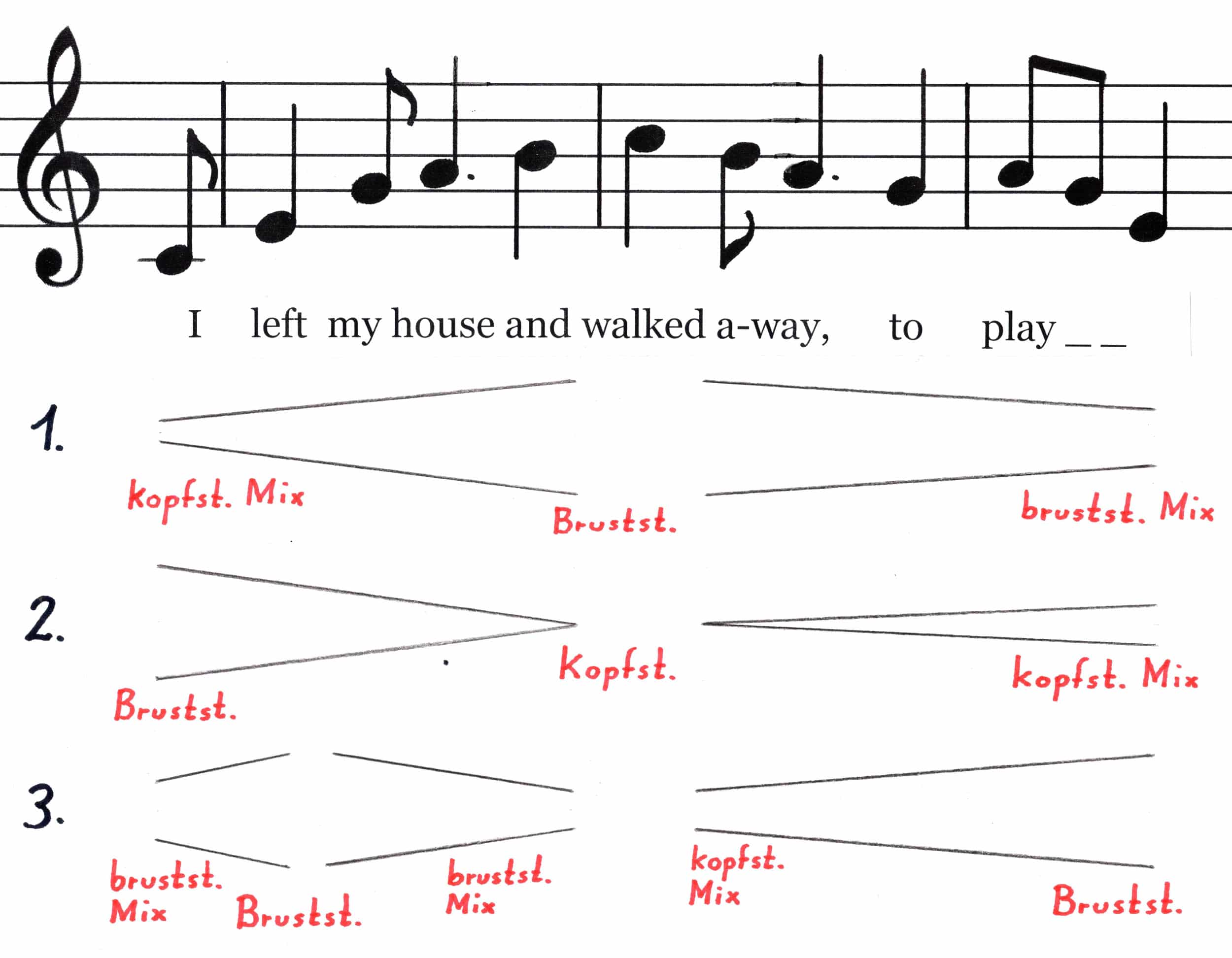
You can also find good exercises for register changes, support or expanding your vocal range in my online singing courses. Take a look at the courses I offer: https://singasong-behappy.de/online-gesangsunterricht/






